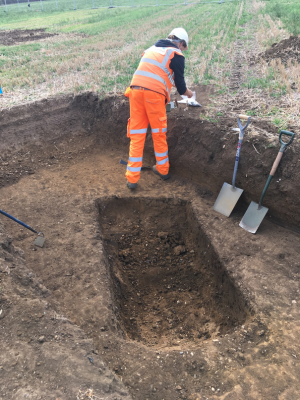Archaeology update: trial-trenching at Laleham
Senior Archaeologist Catherine Charman discusses latest River Thames Scheme archaeological work and what it could reveal about the history and heritage of the Laleham area.
Archaeological surveys are an important part of the River Thames Scheme (RTS). They help us to understand the significance of surviving archaeological remains and what sort of work may be needed to mitigate the effects of construction.
Why is the River Thames Scheme carrying out additional archaeological work in the Laleham area?
The RTS includes proposed areas for recreation and for improved habitat. Part of the additional archaeological trial trenching at Laleham will take place in an area that is proposed for use as part of the active travel route. We need to know what archaeology may be present in order to assess the impact to heritage from that part of the RTS and to decide what mitigation is required.
Part of the trial trenching is located on the Scheduled Monument at Laleham. The RTS is not planning any work on the monument itself, but habitat improvement may take place around it. The Scheduled Monument has been previously identified as a Roman fortlet [a small fort], but recent thinking has questioned this and suggested that the old earthworks may be a medieval or post-medieval livestock enclosure.
As archaeological excavations have never taken place to confirm what the monument is, Historic England has given us permission to carry out limited trial trenching so we can try and answer this question. The answer will influence the type of habitat that will be planned.
What is archaeological trial trenching?
Archaeological trial trenching is where archaeologists dig trenches to evaluate what archaeology may survive below the ground. This is an intrusive technique that we only carry out after we have completed non-intrusive methods such as desk-based research and geophysical surveys. Then we can use the results from these to locate our trenches in the best locations.
Trial trenches are usually long and thin, but they can be any rectangular shape or size. Ours on the RTS are usually 2m x 30m.
The results from archaeological trial trenching will be used to assess the impact to heritage from the RTS and to decide what mitigation is required.
What does the work involve?
 The archaeological trial trenches will initially be excavated using mechanical diggers fitted with toothless buckets. These will be used to remove the top layers of soil under the watchful eyes of our archaeologists. Once the soil is removed down to either the first layers of archaeology or the natural geology, then the machine excavation stops and the archaeologists begin their digging using hand tools.
The archaeological trial trenches will initially be excavated using mechanical diggers fitted with toothless buckets. These will be used to remove the top layers of soil under the watchful eyes of our archaeologists. Once the soil is removed down to either the first layers of archaeology or the natural geology, then the machine excavation stops and the archaeologists begin their digging using hand tools.
If there are archaeological features found within the trench, such as pits or ditches, then the archaeologists will dig sections through them to recover finds to date the feature and to draw and record the features. The archaeologists may take away environment samples to analyse in order to gain information on the past environment. Sometimes there is no archaeology to be found within a trench in which case that is also recorded.
Once the archaeologists have finished, the trench is backfilled with the removed soil being replaced in the order it came out so the topsoil with all the seeds will be at the ground surface.
How are the finds recorded?
If we find any archaeological artefacts then these can be recorded in two ways. Finds such as pottery, animal bone, and brick and tile are collected in bulk according to the deposit in which they were found. Finer objects like metal, coins, or glass items are recorded as Registered Artefacts and their precise location is noted. These finds are packaged individually according to their material as some require delicate handling.
At the nearby Abbey Meads site, the RTS archaeologists recovered fragments of Bronze Age pottery and it is possible that similar pottery may be found at the Laleham site. At the Scheduled Monument we are hoping for definitive Roman, medieval, or post-medieval pottery in the earthwork ditches so that we can conclusively date this monument.
What happens if the trial trenching discovers something that's archeologically important?
This would depend on what was discovered. If it was something that could be picked up, like an axe head or a coin, then this would be removed and taken away for conservation. If it was an archaeological feature or an entire site, such as a well or a house, then the archaeologists would gather enough evidence to try and answer questions such as: what is its date, what kind of structure is it and how well is it preserved?
They could then come back and fully excavate it with proper resources and time prior to construction of the RTS. Remember that trial trenching is just a method used to identify and evaluate archaeology.
